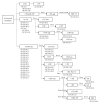The Clinical Outcomes of Cervical Spine Chordoma: A Nationwide Multicenter Retrospective Study
- PMID: 39363489
- PMCID: PMC11456934
- DOI: 10.14245/ns.2448448.224
The Clinical Outcomes of Cervical Spine Chordoma: A Nationwide Multicenter Retrospective Study
Abstract
Objective: Chordoma, a rare malignant tumor originating from embryonal notochord remnants, exhibits high resistance to conventional treatments, making surgical resection imperative. However, the factors influencing prognosis specifically for cervical spine chordoma have not been clearly identified. We investigate the prognosis of cervical spine chordoma with factors influential in a nationwide multicenter retrospective study.
Methods: This study included all patients diagnosed with cervical spine chordoma at 7 tertiary referral centers from January 1998 to March 2023, excluding those with clivus and thoracic spine chordomas extending into the cervical spine. Local recurrence (LR) was identified through follow-up magnetic resonance imaging, either as reappearance in completely resected tumors or regrowth in residual tumors. The study assessed LR and overall survival, analyzing factors influencing LR and death.
Results: Forty-five patients with cervical spine chordoma had a mean age of 46.4 years. Over a median follow-up of 52 months, LR and distant metastasis were observed in 21 (46.7%) and 4 patients (8.9%), respectively, and 16 patients (36%) were confirmed dead. The 5-year and 10-year cumulative LR rates were 51.3% and 60%, respectively, while the 5-year and 10-year survival rates were 82% and 53%. Age was the only significant factor affecting mortality (hazard ratio, 1.04; 95% confidence interval, 1.04-1.07; p=0.015). Notably, the degree of resection and adjuvant therapy did not statistically significantly impact local tumor control and mortality.
Conclusion: This study, the largest multicenter retrospective analysis of cervical spine chordoma in Korea, identified age as the only factor significantly affecting patient survival.
Keywords: Cervical spine; Chordoma; Recurrence; Surgery; Survival rate; Treatment outcome.
Conflict of interest statement
The authors have nothing to disclose.
Figures



References
-
- Berlucchi S, Nasi D, Zunarelli E, et al. Cutaneous metastasis from cervical spinal chordoma: case report and literature review. World Neurosurg. 2020;137:296–303. - PubMed
-
- Das P, Soni P, Jones J, et al. Descriptive epidemiology of chordomas in the United States. J Neurooncol. 2020;148:173–8. - PubMed
-
- McMaster ML, Goldstein AM, Bromley CM, et al. Chordoma: incidence and survival patterns in the United States, 1973–1995. Cancer Causes Control. 2001;12:1–11. - PubMed
-
- Choi D, Melcher R, Harms J, et al. Outcome of 132 operations in 97 patients with chordomas of the craniocervical junction and upper cervical spine. Neurosurgery. 2010;66:59–65. discussion 65. - PubMed
-
- Shen J, Li CD, Yang HL, et al. Classic chordoma coexisting with benign notochordal cell rest demonstrating different immunohistological expression patterns of brachyury and galectin-3. J Clin Neurosci. 2011;18:96–9. - PubMed
Grants and funding
LinkOut - more resources
Full Text Sources

